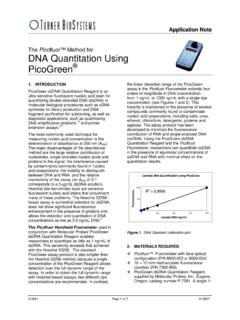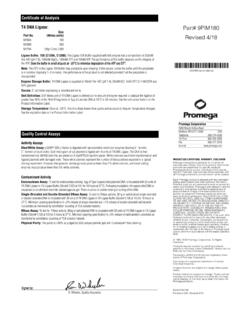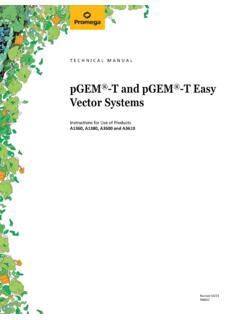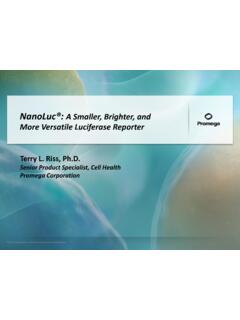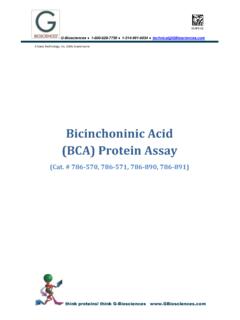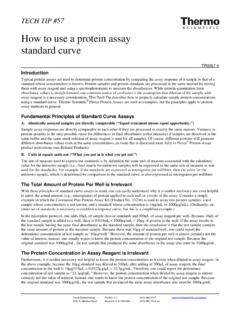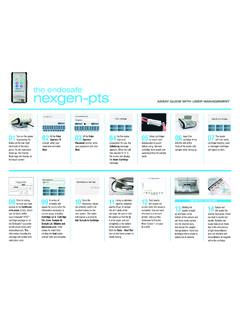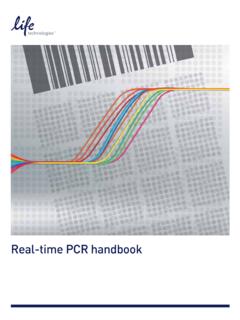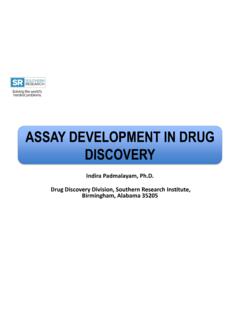Transcription of Dual-Luciferase Reporter Assay System - Promega
1 TECHNICAL MANUAL. Dual-Luciferase . Reporter Assay System Instructions for use of Products E1910 and E1960. Revised 6/15. TM040. Dual-Luciferase . Reporter Assay System All technical literature is available at: Visit the web site to verify that you are using the most current version of this Technical Manual. E-mail Promega Technical Services if you have questions on use of this System : 1. 2. Dual-Luciferase Reporter Assay 3. Format of the Dual-Luciferase Reporter 5. Passive Lysis 6. 2. Product Components and Storage 8. 3. The pGL4 Luciferase Reporter 9. Description of pGL4 9. Important Considerations for Co-Transfection Experiments.
2 9. 4. Instrument 10. Single-Sample 10. Multi-Sample and Plate-Reading 10. Scintillation 11. 5. Preparation of Cell Lysates Using Passive Lysis 12. Passive Lysis Buffer 12. Passive Lysis of Cells Cultured in Multiwell 12. Active Lysis of Cells by 13. 6. Dual-Luciferase Reporter Assay 14. Preparation of Luciferase Assay Reagent 14. Preparation of Stop & Glo 15. Standard 15. Important Considerations for Cleaning Reagent 18. Determination of Assay 19. 7. 21. 8. 22. Composition of Buffers and 22. Related 22. 9. Summary of 25. Promega Corporation 2800 Woods Hollow Road Madison, WI 53711-5399 USA Toll Free in USA 800-356-9526 608-274-4330 Fax 608-277-2516 1.
3 TM040 Revised 6/15. 1. Description Genetic Reporter systems are widely used to study eukaryotic gene expression and cellular physiology. Applications include the study of receptor activity, transcription factors, intracellular signaling, mRNA processing and protein folding. Dual reporters are commonly used to improve experimental accuracy. The term dual Reporter refers to the simultaneous expression and measurement of two individual Reporter enzymes within a single System . Typically, the experimental Reporter is correlated with the effect of specific experimental conditions, while the activity of the co-transfected control Reporter provides an internal control that serves as the baseline response.
4 Normalizing the activity of the experimental Reporter to the activity of the internal control minimizes experimental variability caused by differences in cell viability or transfection efficiency. Other sources of variability, such as differences in pipetting volumes, cell lysis efficiency and Assay efficiency, can be effectively eliminated. Thus, dual- Reporter assays often allow more reliable interpretation of the experimental data by reducing extraneous influences. The Dual-Luciferase Reporter (DLR ) Assay System (a c) provides an efficient means of performing dual- Reporter assays. In the DLR Assay , the activities of firefly (Photinus pyralis) and Renilla (Renilla reniformis, also known as sea pansy) luciferases are measured sequentially from a single sample.
5 The firefly luciferase Reporter is measured first by adding Luciferase Assay Reagent II (LAR II) to generate a stabilized luminescent signal. After quantifying the firefly luminescence, this reaction is quenched, and the Renilla luciferase reaction is simultaneously initiated by adding Stop & Glo Reagent to the same tube. The Stop & Glo Reagent also produces a stabilized signal from the Renilla luciferase, which decays slowly over the course of the measurement. In the DLR Assay System , both reporters yield linear assays with subattomole sensitivities and no endogenous activity of either Reporter in the experimental host cells.
6 Furthermore, the integrated format of the DLR Assay provides rapid quantitation of both reporters either in transfected cells or in cell-free transcription/translation reactions. Promega offers the pGL4 series of firefly and Renilla luciferase vectors designed for use with the DLR Assay Systems. These vectors may be used to co-transfect mammalian cells with experimental and control Reporter genes. 2 Promega Corporation 2800 Woods Hollow Road Madison, WI 53711-5399 USA Toll Free in USA 800-356-9526 608-274-4330 Fax 608-277-2516. TM040 Revised 6/15 Dual-Luciferase Reporter Assay Chemistry Firefly and Renilla luciferases, because of their distinct evolutionary origins, have dissimilar enzyme structures and substrate requirements.
7 These differences make it possible to selectively discriminate between their respective bioluminescent reactions. Thus, using the DLR Assay System , the luminescence from the firefly luciferase reaction may be quenched while simultaneously activating the luminescent reaction of Renilla luciferase. Firefly luciferase is a 61kDa monomeric protein that does not require post-translational processing for enzymatic activity (1,2). Thus, it functions as a genetic Reporter immediately upon translation. Photon emission is achieved through oxidation of beetle luciferin in a reaction that requires ATP, Mg2+ and O2 (Figure 1).
8 Under conventional reaction conditions, the oxidation occurs through a luciferyl-AMP intermediate that turns over very slowly. As a result, this Assay chemistry generates a flash . of light that rapidly decays after the substrate and enzyme are mixed. Many of our Luciferase Assay Reagents for quantitating firefly luciferase incorporate coenzyme A (CoA) to provide more favorable overall reaction kinetics (3). In the presence of CoA, the luciferase Assay yields stabilized luminescence signals with significantly greater intensities (Figure 2) than those obtained from the conventional Assay chemistry.
9 The firefly luciferase Assay is extremely sensitive and extends over a linear range covering at least seven orders of magnitude in enzyme concentration (Figure 3). Renilla luciferase, a 36kDa monomeric protein, is composed of 3% carbohydrate when purified from its natural source, Renilla reniformis (4). However, like firefly luciferase, post-translational modification is not required for its activity, and the enzyme may function as a genetic Reporter immediately following translation. The luminescent reaction catalyzed by Renilla luciferase utilizes O2 and coelenterate-luciferin (coelenterazine; Figure 1).
10 Figure 1. Bioluminescent reactions catalyzed by firefly and Renilla luciferases. Promega Corporation 2800 Woods Hollow Road Madison, WI 53711-5399 USA Toll Free in USA 800-356-9526 608-274-4330 Fax 608-277-2516 3. TM040 Revised 6/15. Dual-Luciferase Reporter Assay Chemistry (continued). In the DLR Assay chemistry, the kinetics of the Renilla luciferase reaction provide a stabilized luminescent signal that decays slowly over the course of the measurement (Figure 2). Similar to firefly luciferase, the luminescent reaction catalyzed by Renilla luciferase also provides extreme sensitivity and a linear range generally extending six orders of magnitude (Figure 3).


